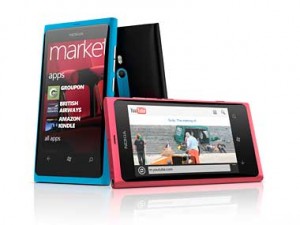Not long after Nokia announced that it was abandoning its own high-end smartphone platform for Microsoft’s Windows Phone, I asked an industry expert what he thought of the tie up.
“Tying together two rocks doesn’t make them float,” he said. In a few short years, Nokia had lost what seemed like an insurmountable lead in the mobile phone industry, especially in high-end smartphones, a category that it had helped pioneer.
Nokia’s woes have been focused on falling sales of its smartphones rather than the basic feature phones, as they are known in the industry. In its most recent results, Nokia reported a38% decline in smartphone sales over the last year. The decline cut its global share of the smartphone market almost in half since last December, when it held 27.5% of the market falling to 15.5% in September, according to IDC.
Microsoft, on the other hand, is not so much a company in crisis as much as a company looking for new lands to conquer. Although its flagshipWindows operating system has slipped below 90% market share, it is still dominant, and people often forget howdominant and profitable its Office software suite is.
Those two cash cows continue to drive profits at the company. In the most recent quarter, Microsoft reported net income of $5.74bn on revenue of $17.87bn, a year-over-year increase of 7%.
For years, Microsoft has been looking for new markets to launch its next round of growth. Its Xbox gaming console is definitely growing into another strong business for the company, especially as it grows into more of a home entertainment hub.
However, despite its best efforts, Microsoft has yet to crack mobile. Its Windows Phone software is an also ran, and it is rumoured that Microsoft makes more, five times more by one analyst’s estimate, on licence fees from Android than it does in selling its own mobile OS.
To give its mobile efforts a boost, Microsoft needed a tie-up like Nokia, which still has a strong brand and a loyal following.
Nokia CEO Steven Elop knew the challenge, rallying the troops with the now famous ‘burning platform’ memo, and he’s done a good job in the short term. The company has taken a beating this year, losing almost a half billion Euros in the last two quarters, but analysts say that Nokia is ahead of schedule in its turnaround.
What Nokia and Microsoft need to do
In introducing its new phones Wednesday, Elop noted that Asha, the name of its new emerging market phones, means hope in Hindi, and Lumia, the name of its new Windows Phone smartphones, mean light. Elop tried to cast the launch as a rebirth of the company.
Both companies need to do several things to ensure that their partnership is greater than the sum of its parts.
Microsoft has actually taken several key steps to not only help Nokia but also its flagship Windows operating system. It did something that it hadn’t done in a long time, it generated some much needed buzz with a developers release of its Windows 8 operating system.
Windows 8 obviously has been taking cues from Windows Phone, and developers not only got the OS to play with but also a tablet to use as well.
Windows 8 will also run on chips with the low-power, mobile friendly ARM architecture, not just Intel and AMD chips. Various flavours of ARM chips run the vast majority of mobile devices, whether they are phones or tablets.
It starts to bring the leverage of Windows on the desktop to Windows on tablets and to a lesser extent on the phone.
Microsoft is also bringing Xbox Live to Windows phone, leveraging another strength. Redmond is good at that. Microsoft is definitely moving in the right direction, but it needs to up the pace.
Nokia might have lost market share, but it still has loyal customers, especially in India. One thing it has to do now is bring its loyal developers with it. The company knows that it has to do this, and that is why Elop talked about building an ecosystem around its news Windows Phone handsets.
In the smartphone world, software is almost as important as hardware. You just have to see the app store wars between Apple and Android to see evidence of that. They both boast about the number of apps and sales of apps for their phones.
Nokia had an app store long before most people knew what they were, but developers almost exclusively build apps for the iPhone and Android handsets. Nokia and Microsoft need to work hard with developers so that they make the Windows Phone their third choice. This isn’t just a battle for the pocketbooks of smartphone buyers but also for developers who make the cool apps we all want.

No comments:
Post a Comment